Samsung SSD 840 Pro (256GB) Review
by Anand Lal Shimpi on September 24, 2012 7:00 AM EST- Posted in
- Storage
- SSDs
- Samsung
- Samsung SSD 840
Random Read/Write Speed
The four corners of SSD performance are as follows: random read, random write, sequential read and sequential write speed. Random accesses are generally small in size, while sequential accesses tend to be larger and thus we have the four Iometer tests we use in all of our reviews.
Our first test writes 4KB in a completely random pattern over an 8GB space of the drive to simulate the sort of random access that you'd see on an OS drive (even this is more stressful than a normal desktop user would see). I perform three concurrent IOs and run the test for 3 minutes. The results reported are in average MB/s over the entire time. We use both standard pseudo randomly generated data for each write as well as fully random data to show you both the maximum and minimum performance offered by SandForce based drives in these tests. The average performance of SF drives will likely be somewhere in between the two values for each drive you see in the graphs. For an understanding of why this matters, read our original SandForce article.
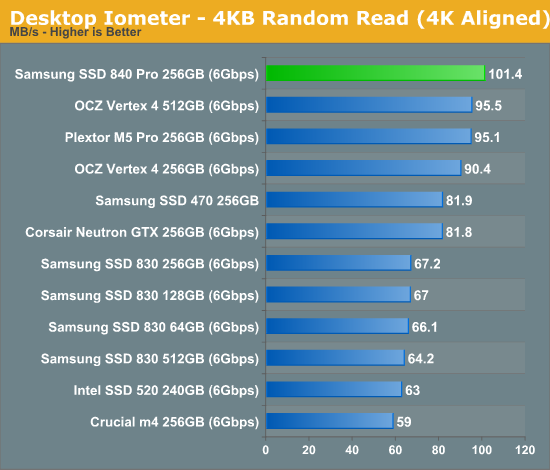
We have a new king, the 840 Pro manages to inch past the fastest Vertex 4 in our random read performance test.
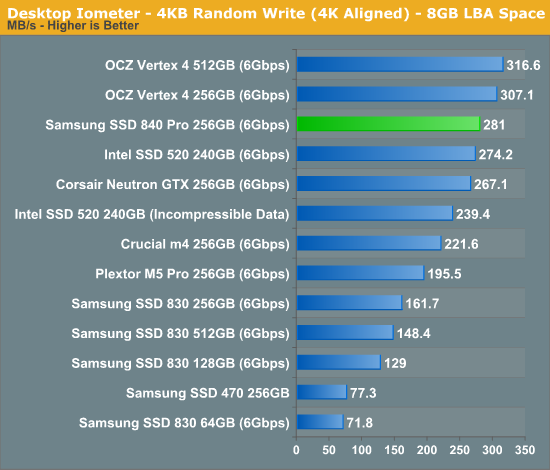
The low queue depth random write performance crown goes back to the Vertex 4, but the 840 Pro is around 75% faster than the old 830. Other than the Vertex 4, there's nothing faster than the 840 Pro here.
Many of you have asked for random write performance at higher queue depths. What I have below is our 4KB random write test performed at a queue depth of 32 instead of 3. While the vast majority of desktop usage models experience queue depths of 0 - 5, higher depths are possible in heavy I/O (and multi-user) workloads:
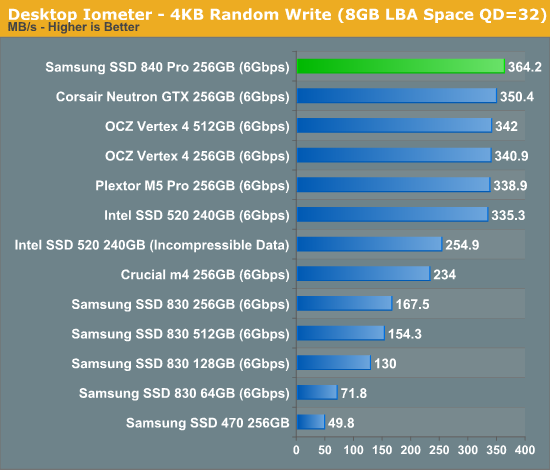
Ramp up queue depth and the 840 Pro manages to even outperform Corsair's new Neutron GTX.
Sequential Read/Write Speed
To measure sequential performance I ran a 1 minute long 128KB sequential test over the entire span of the drive at a queue depth of 1. The results reported are in average MB/s over the entire test length.
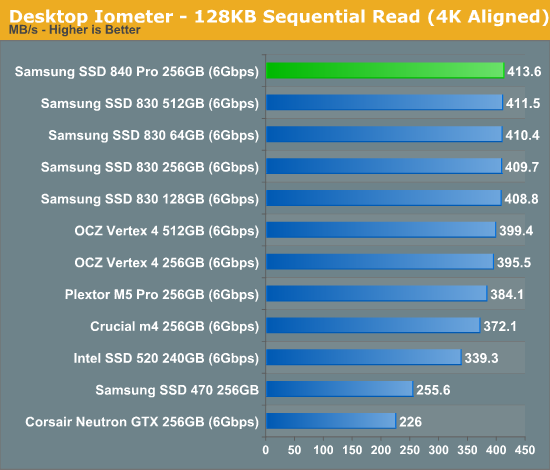
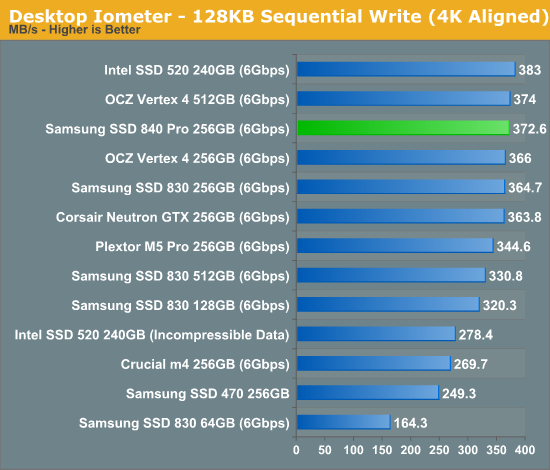
There are no tradeoffs here: excellent random IO performance and class leading low queue depth sequential performance. The 840 Pro is looking like a good all-around performer.
AS-SSD Incompressible Sequential Performance
The AS-SSD sequential benchmark uses incompressible data for all of its transfers. The result is a pretty big reduction in sequential write speed on SandForce based controllers.

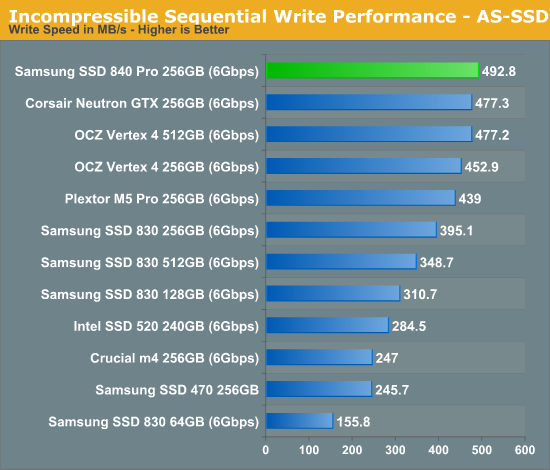
The 840 Pro lands on top once again in these higher queue depth sequential tests. The competition is hot on the heels of the 840 Pro however, we're limited by 6Gbps SATA here so expect continued clustering around 500MB/s going forward.










96 Comments
View All Comments
stoked - Monday, September 24, 2012 - link
Do these drives include power loss protection like the Intel 320's?Kristian Vättö - Monday, September 24, 2012 - link
Simply and shortly, no. However, Samsung showed a few enterprise SSDs as well, which may have (they were simply on display, so I'm not sure).lunadesign - Monday, September 24, 2012 - link
Anand - How does this drive do in cases where TRIM isn't an option? How does it compare to the M5 Pro in this area?kpo6969 - Monday, September 24, 2012 - link
Anand- If you only had a choice of two drives to put in your own system would you go with this one or the Plextor M5 Pro? Just wondering, thanks.Zoomer - Monday, September 24, 2012 - link
However, the new Sandforce controller isn't out yet. We'll see.Magichands8 - Monday, September 24, 2012 - link
Technically this all looks great. Nice performance and power characteristics across the board. But where is the real distinguishing factor? All these drives are getting capped out thanks to SATA limitations and how much am I going to notice the difference between 500 MB/s and 490 MB/s in real world usage? Prices remain high and capacities remain low. We have reliability, high performance, low power usage and even TRIM over RAID now. SAMSUNG, INTEL, MICRON, OCZ, SANDISK, are you listening?! We need higher CAPACITIES, NOT irrelevant PERFORMANCE gains from intermittent firmware tweaks every six months!I read somewhere that it's going to take another year/year-and-a-half for them to build/expand/retool plants to the point where we can see reasonable capacity increases at reasonable prices but it's very frustrating and disappointing to see basically no improvement upon capacities with extremely sluggish price improvement. It's getting to the point where I'm not even interested in new SSD reviews anymore.
However if capacities ever hit 2TB+ for $250-$300 I have a hard time imagining what could compel me to buy traditional HDDs when my main concerns with such an array would boil down to a mechanical failure somewhere, heat, noise and space (which are all addressed by SSDs). I'm sure that the new tech coming down the pipes for magnetic storage are going to do wonders for capacities but at some point that almost becomes a liability since there will always be a huge performance bottleneck.
seapeople - Monday, September 24, 2012 - link
Considering that I paid ~$2/GB for an Intel SSD just 18 months ago, and now drives that are twice as fast are selling for half as much, I'd say you're being unreasonably impatient.Grok42 - Monday, September 24, 2012 - link
Prices are going down, they are still just very high per GB compared to magnetic drives. If they can get in the range of double the cost of HDDs in the next 2-3 years I think you'll see everything move over to SSD given all the other benefits.I think what you're feeling is that the capacity isn't going up at all. I can't really see being able to buy a 2TB SSD for less than $400 in the next few years. I do see being able to buy a 250GB drive for $80 which is about 2x what an equivalent 500GB regular HDD costs if you bought two SSDs. Seems capacity is very non-linear and nothing has improved.
FunBunny2 - Tuesday, September 25, 2012 - link
The capacity issue could be mitigated a whole bunch if the SSD folks built them on 3.5 form factor. Some truly enterprise SSD vendors till do. The volume difference is substantial. Instead, we get TLC stuff.Death666Angel - Tuesday, September 25, 2012 - link
3.5" drives have the same dice in there as 2.5" drives and the controller PCB layout wouldn't be any cheaper either. If you look at prices of current generation SSDs, the 256GB version usually have the best price/GB. Unless you are saying that NAND packages with more dice are more expensive (which I can't see when I compare drives of different NAND package sizes with one another, often enough those with 4 dice are cheaper than those with 2 dice), then I don't see how going to 3.5" SSDs is going to make capacities cheaper.